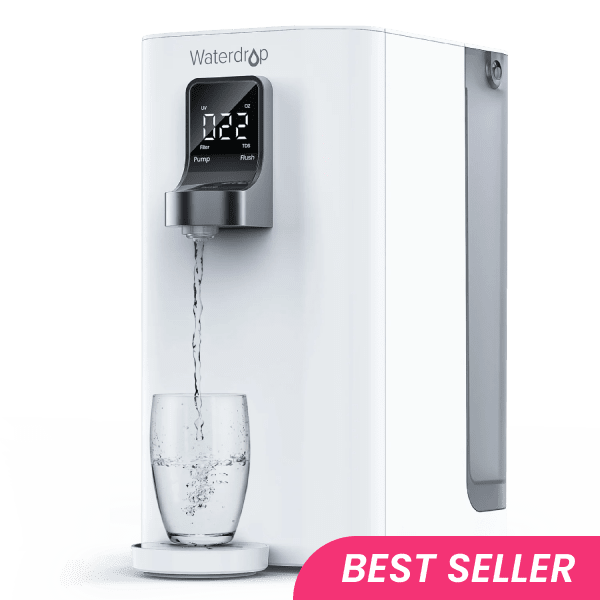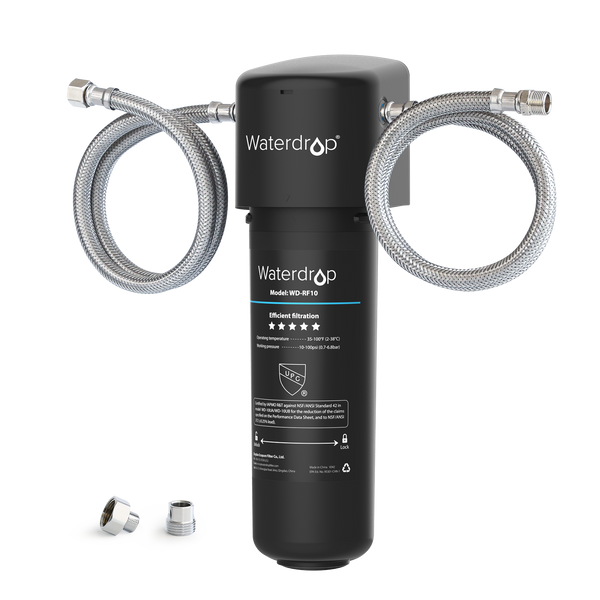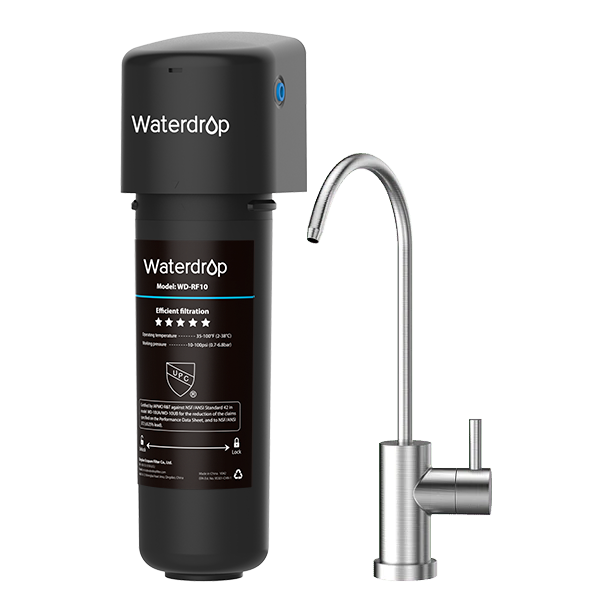Water Softener VS Reverse Osmosis Water Filter VS Tankless RO Filtration Systems
by Dr. Jonathan Doyle - Updated April 01, 2024
Are you not sure whether to get a water softener or a reverse osmosis system for
your house? Choosing wisely can have a significant impact on the daily water quality that you and your family
drink. To assist you in making a well-informed decision, this long and detailed guide will examine the
distinctions between these two water treatment alternatives.
Reverse osmosis
systems and water softeners address different problems with water quality, which makes them appropriate
for different applications. A water softener's main job is to fix hard water, which has a lot of magnesium and
calcium minerals in it. Conversely, a reverse osmosis system concentrates on eliminating a wider variety of
impurities, chemicals, and minerals.
What Is Reverse Osmosis Water Filter?
In the process of osmosis, which happens spontaneously, a weak saline solution
moves towards a stronger saline solution. In other words, a less concentrated solution will naturally be
inclined to move toward a more concentrated solution. Reverse osmosis is the opposite of osmosis, as you might
have guessed.
The presence of a semi-permeable membrane
is essential to reverse osmosis. This technology purifies water by using a semi-permeable membrane to eliminate
impurities, leaving the water tasteless and pure. Water molecules are separated from impurities like silt,
chlorine, and lead as they pass through the membrane.
How Does a Reverse Osmosis Water Filter Work?
You may be excited to investigate the beneficial uses of reverse osmosis in
everyday life now that you know how it works. With an amazing capacity, Waterdrop has introduced its new reverse
osmosis water filtration system.
Waterdrop X Series Reverse Osmosis System
Its large 1600G capacity allows it to deliver water at an amazing rate; in just two
seconds, a 6 oz cup can be filled. This under-sink reverse osmosis system, when combined with original PCC
mineralization technology, activates specific mineral crystals to simulate the natural formation of spring
water, bringing the pH of the purified water to an ideal, body-friendly 7.5±.
This filter is capable of efficiently removing lead, arsenic, PFOA, PFOS, chlorine,
fluoride, and TDS, among other contaminants. It features an 11-stage precision filtration system with a
reinforced RO (Reverse Osmosis) membrane measuring 0.0001μm. This tankless reverse osmosis system has an
electronic faucet with adjustable water flow. Real-time TDS and filter life monitoring make it simple to monitor
the quality of your water.
Traditional RO System VS Tankless RO Water Filter
Storage tanks were essential in the early development of water filter systems.
Nevertheless, these systems frequently encountered difficulties, such as poor water flow rates, which caused
users to wait for clean water. The idea of keeping filtered water in sealed pressure tanks originated as a
solution to this problem.
Users can enjoy the benefits of having access to purified water straight from a
stored source when they use a Tank RO water purifier. There are no waiting times because the water is
pre-filtered and kept in a sealed pressure tank, giving users immediate access to clean water.
Pros
- Preserves water for later use, guaranteeing a steady supply.
- Fast and easy access to clean water.
- Provides backup during brief interruptions in the water supply.
Cons
- It can take some time to filter or heat water, so planning ahead is necessary.
- Takes up space, so before installing it, the dimensions of the kitchen sink must be taken into account.
- The sealed pressure tank may be the source of secondary pollutants, necessitating close observation and upkeep.
Tank RO water purifiers are convenient, but before making a purchase, consider the
benefits and drawbacks depending on your needs and the size of your kitchen.
Comparing this unique drinking water filtration system to conventional tank-based
RO purifiers, there are a number of benefits. First of all, it frees up valuable under-sink space by doing away
with the need for a large storage tank. Furthermore, the system successfully removes the possibility of
secondary pollution from standing water by removing the storage tank.
Pros:
- 1.Compact design: The unit takes up a lot less room under the kitchen sink because it doesn't need a storage tank.
- 2.Removing secondary pollution: You can finally wave goodbye to worries about contaminants building up within a storage tank.
- 3.Instant access to cool water: Whenever you need it, take pleasure in drinking pure water in a matter of seconds.
Cons:
Higher cost: In comparison to traditional models, tankless RO water purifiers are
usually more expensive.
With its advanced composite filters and tankless design, the Waterdrop reverse
osmosis system is a model solution in the US market that raises the bar. Modern filtration technology
minimizes space requirements while guaranteeing a steady supply of pure, refreshing reverse osmosis water. With
this system, the risk of bacterial growth is reduced and new standards for convenience and water purity are set
by doing away with the conventional storage tank.

A Water Softener: What Is It?
An essential whole-house filtration system for dealing with hard water is a water
softener, which works by drawing out the minerals calcium and magnesium. which serve as the cause of water
hardness, through an ion exchange process. Hard water can be very problematic for homes, resulting in a variety
of problems that can affect appliances and daily activities.
Hard water-affected homes often have a persistent issue with scale accumulation,
which can cause blockages in pipes and low water pressure. Scale buildup shortens the lifespan of appliances
like ice makers, coffee makers, and dishwashers. Hot water appliances are especially vulnerable because the high
temperature promotes the solidification of magnesium
and calcium deposits in water heaters. As a result, the heating elements may develop dangerous scale
formations that sound like popping popcorn when the tank expands.

The lack of a water softener makes laundry more difficult, necessitating the use of
more detergent to prevent dinginess. Dishes from dishwashers frequently have streaks and stains, and filmy scum
builds up in shower curtains. Hard water baths can also cause skin to feel dry and itchy and hair to look sticky
and lifeless. It will take a significant amount of time, money, and effort to resolve these problems without a
water softener.
How Does a Water Softener Work?
A water softener works by removing magnesium and calcium from water through an ion
exchange process. Hard water flows through a layer of spherical resin beads, usually made of polystyrene, as it
enters the mineral tank. These resin beads are known as anions with their negative charge and abundance of
sodium ions.
The positive charge of the magnesium and calcium minerals in hard water, also
referred to as cations, causes them to gravitate toward the resin beads because opposite charges attract. The
resin beads successfully extract the mineral ions from the water by capturing them as hard water passes through
them. The resin captures the mineral ions and releases sodium ions in the process.

Proceeding with this procedure, the resin column gradually eliminates hardness from
the water as it flows through the mineral tank, supplying your home with softened water in the end. This process
guarantees that the harmful effects of magnesium and calcium are removed from your water, giving you a more
effective and pleasurable experience.
Advantages of Home Water Softening
- Prevents mineral deposits scale from accumulating within fixtures, pipelines, and hot water heaters.
- Extends the lifespan of specific appliances.
- Minimizes or avoids mineral stains on glasses.
- Minimizes or avoids soap residue and detergent clumps in sinks, bathtubs, and laundry machines.
Disadvantages of Home Water Softening
- It may cause corrosion in your pipes. Theres a chance that your water contains rusted metal from the pipes. This may be a factor in the high levels of copper and lead found in drinking water.
- Additional sodium could have negative effects on your health.
- To ensure that the softener is operating correctly, routine maintenance and water testing are required.
- Use of salt has harmful effects on the environment.
- Wastewater is produced when the softener beads are renewed with water.
Do I Need to Soften My Water?
Softening your water is not necessary. Softening is a personal choice that has an
impact on the environment and your house. In the event that the water hardness surpasses 7 grains per gallon, or
120 mg/L, it may be necessary to employ a water softener to uphold the optimal performance of household
appliances and improve the apparent taste, and odor qualities of the water.
Contaminants Detected in Fruitland Water Special Service District
30
Contaminants
EXCEED EWG HEALTH GUIDELINES
EXCEED EWG HEALTH GUIDELINES
30 Total Contaminants in Your Water
Water Provider
Fruitland Water Special Service DistrictPopulation Affected
120,000Water Source
Ground waterExceeds Guidelines
Others Detected















